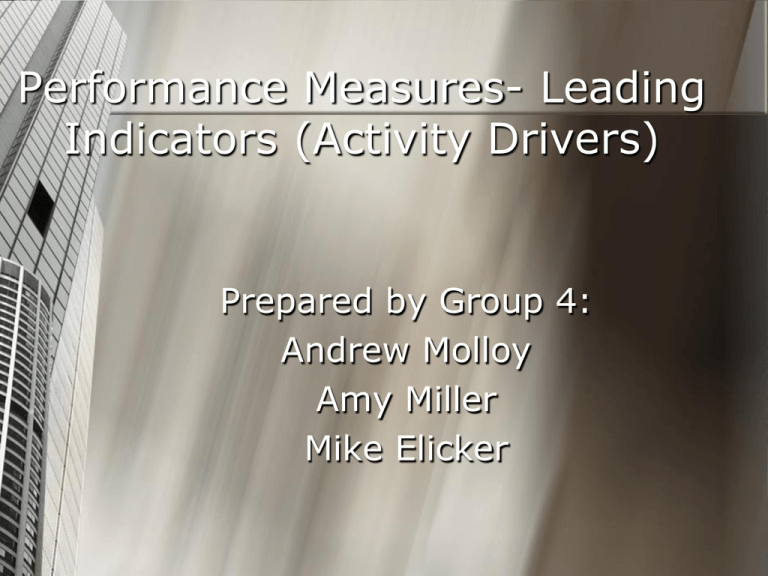Performance Measures- Leading Indicators (Activity Drivers)
advertisement

Performance Measures- Leading Indicators (Activity Drivers) Prepared by Group 4: Andrew Molloy Amy Miller Mike Elicker Steps to leading performance measures Leading performance measures are based on activity drivers that drive the performance of a company. 1. The first step in performance measurement are activity drivers that drive the performance of a company. 2. The second step to reaching your overall goal in performance is leading performance indicators. 3. The third step to reaching your company’s overall goal are the specific results your company is looking for. Performance Drivers Performance drivers are structured around trying to achieve a firms overall goals, strategies, and objectives. Performance drivers are the: process, learning, and alignment of the employees working toward performance indicators. By continuing to develop performance drivers leading toward effectiveness and efficiency a company will be heading toward their overall goal. Performance Indicators Performance indicators- represent a set of measures focusing on the aspects of organizational performance that are the most often critical for the current and future success of the organization. There are several examples of performance indicators that a company might use. Some of these examples include: Environmental Customer Competitor Internal Human resource These indicators will help for a business to categorize their indicators into groups to help them measure and set up their performance drivers to work toward their results and specific goals. Results The results of the activity drivers and performance indicators are what a company sets their overall goals for. Some results that a company might be aiming for are customer satisfaction, cost per resolution, and employee satisfaction. These results can be reached when a company has all of these steps in place and fallow them in reaching their overall goal to be a successful business. Diagram of relationships between Performance drivers, Leading indicators, and results There are many types of leading indicators throughout a company that affect performance Company performance includes leading indicators of: Customer Satisfaction Growth and Retention Internal Operations -efficiency, speed, minimizing quality problems Human Resource Systems A further breakdown of leading indicators shows which drivers lead to specific results… Indicators can be broken down into smaller categories: 1. Organizational 2. Environmental 3. Group/Departmental 4. Facility/Individual Environmental: Outside factors such as government regulations, economic cycle, politics Example: Economy is headed for a recession. Company must plan to be ahead of the curve. Solution: Address the orders dept. Measure how many orders should be decreased to account for a slowing economy. Organizational: Company Strategy, Policy, Structure Example: Mgmt wants to increase sales of Product A Solution: The amount of Research and Development of Product A needs to be measured to determine how many hours to increase by. Group/Departmental: Group relationships, responsibility, and assignments Example: Mgmt wants to increase inter- office group relations. Mgmt may determine they want to do this by increasing time spent working in teams. Amount of hours per week increased of working in teams must be measured. Individual: Management style, skills, behavior Example: Mgmt feels productivity will increase if employee skills are higher. Solution: Extra training and classes may be required to achieve this. Measurement of hours required to raise employee skills must be conducted. Key Point: Measures of these drivers must be tied to what the company is trying to accomplish Other Common Leading Indicators Increase returning customers by 15% this year……gain more market share Reduce employee turnover this year……improve efficiency Increase sales is a particular department…..boost overall sales Advantages There is a closer link to longterm organizational strategies Example- improving customer relations, market competition, expanding new product development, or expanding organizational capabilities may be important strategic goals, but may hinder short-term accounting performance. Advantages Critics of traditional measures argue that drivers of success in many industries are “intangible assets,” rather than figures on the balance sheet A recently published study found that measures related to company innovation, management capability, employee relations, quantity, and brand value explained a significant proportion of a company’s value, even after factoring in accounting assets and liabilities Advantages Often times non-financial indicators can be better indicators of future financial performance For example, when the ultimate goal is maximizing financial performance, current measures may not capture longterm benefits from decisions currently being made. Investments in customer satisfaction can improve future economic performance by increasing revenues and loyalty of existing customers, and attracting new customers. Drawbacks Time and cost No common denominator No statistical reliability in the measures chosen Implementation Good understanding of value drivers Statistical analysis of leading and lagging indicators of financial performance Business model - help determine which measures best predict future financial performance What contributes to long-term success? Principles for translating corporate objectives into measures that guide management’s daily actions Many companies go wrong here Assign weights to measures based on the strengths of statistical relations Integration Questions?











